Chapel and the Chaplain
For Wellingtonians of the 1940s and 1950s, Chapel was part of everyday life, with attendance every morning and twice on Sundays compulsory for all those nominally Anglican – the vast majority of students. Their experience of Chapel may have been positive, negative, or indifferent, but it was something they all shared.
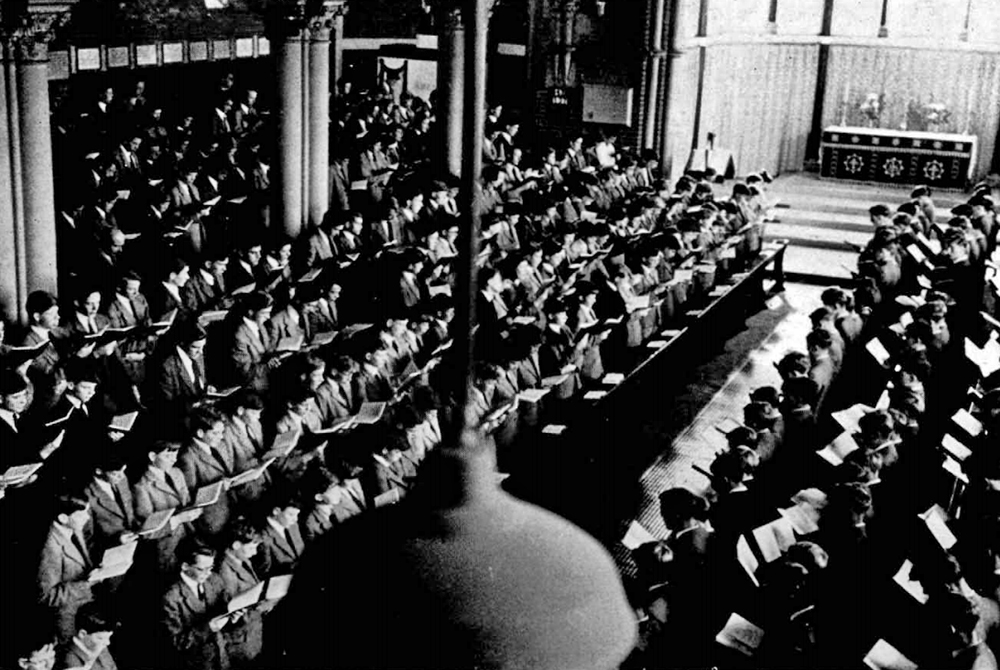
The Chapel routine
According to Charles Wade (Lynedoch 1947-50), ‘On weekdays, the service lasted fifteen minutes, comprising a prayer, psalm (sung), lesson, hymn, and prayer.’
Sundays saw a morning and evening service, the latter including a sermon. Added to this was a voluntary service on Thursday evening and early morning Communion, irreverently referred to as ‘Holy Swipes,’ for those who had been confirmed. House or dormitory life also had a religious component: Alan Munro (Talbot 1948-53) remembers how ‘House prayers each evening were led by Prefects with the Tutor present,’ while Nick Harding (Combermere 1951-55) recalls “‘Prayers in the passage outside one’s “tish” most evenings, perhaps with a short reading from the New Testament, which I think quite impressed me due to the poetic nature of the King James version.’
Most of our respondents accepted daily Chapel attendance with few complaints; typical comments included “We went every day and that was that,” “normal and perfectly acceptable,” Most respondents accepted daily Chapel attendance with few complaints; typical comments included, ‘We went every day and that was that,’ ‘Normal and perfectly acceptable,’ ‘A necessary part of the curriculum,’ and ‘Just part of one’s daily routine.’ A few were less enthusiastic. One anonymous OW felt the mandatory nature of Chapel ‘did rather sour me for religion for a number of years’, while John Thorneycroft (Benson 1953-58) wrote that ‘the frequency of the services was felt to be a bit much even then!’ Some who went on to strong faith and ordination in later life were among the least enthusiastic about their College experience of religion. Thomas Collett-White (Picton 1950-55) considered compulsory daily Chapel attendance ‘dreary,’ making ‘no impression. Post Well. Coll. I discovered “the real thing,”’ while Richard Harries (Hill 1949-54), later Bishop of Oxford, wrote that:
‘Religion consisted of daily morning prayers. This meant in effect switching off when one went into the Chapel and switching on again on leaving.’
Conversely, some of those indifferent to faith were more positive about the experience. According to Christopher Beeton (Talbot 1943-47), ‘An incentive for attending the Thursday evening service was that one was excused one of the two evening preps. But there were some masters who felt their subjects were the ones that were not excused! Another reason for attending, at least if one was in Talbot House, was just to have some fresh air in relaxed conditions in the evening.’
Perhaps the prevailing view was summarised by Chris Heath (Beresford 1948-53), saying ‘I was never really enthusiastic about religion. Nevertheless, the Chapel had a nice design, the seats were not too hard, and the sermons reasonably short.’
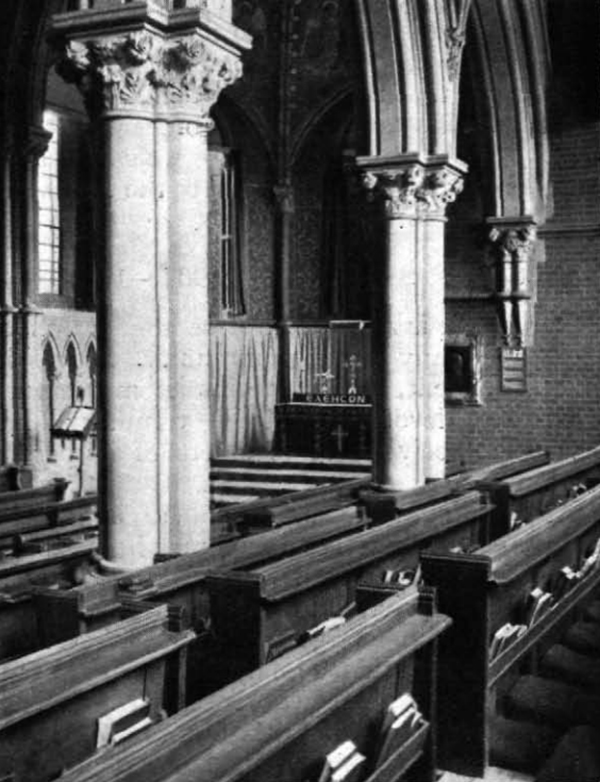
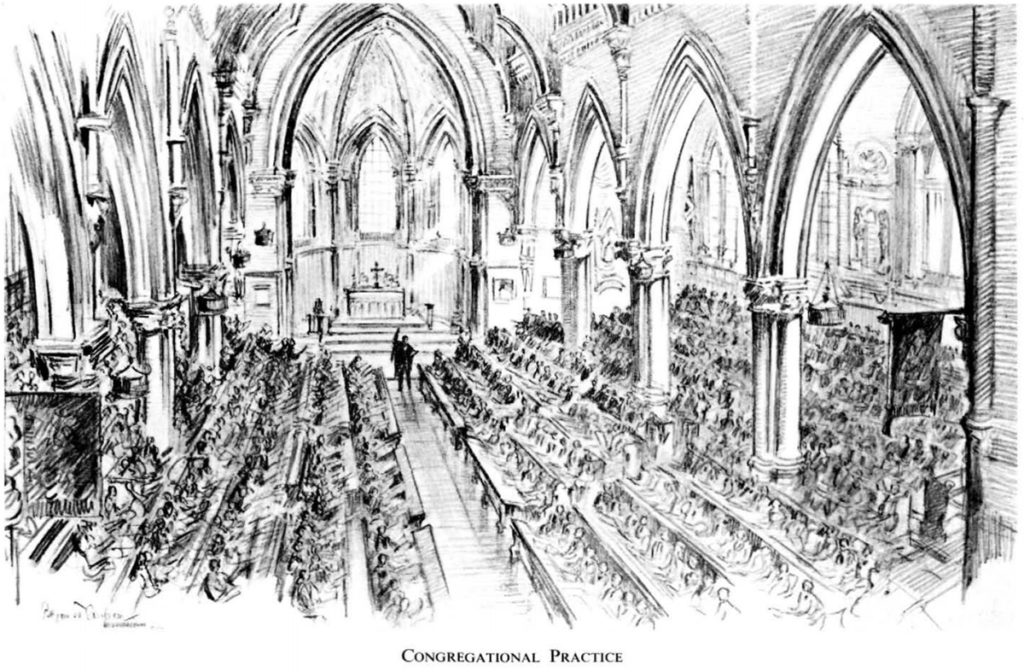
Music in Chapel
Almost all respondents had good memories of the music and singing they experienced in Chapel, whether as members of the choir or the general congregation. Typical comments included:
‘I enjoyed Chapel because, not having a tuneful voice, I liked singing in company.’ Anonymous
‘The hymn singing was rousing and there were many favourites.’
Christopher Stephenson (Hill 1949-54)
‘We all remember the surge of feeling when the full Chapel sang a rousing hymn at the end of term.’ Andrew Dewar-Durie (Talbot 1953-56)
Hugo White (Hardinge 1944-48) commented that ‘once a week, I think on Thursday mornings, the music master, Mr Allen, put us through the hymns and psalms for the coming week so that we had no excuse for not singing lustily,’ while Anthony Bruce (Benson 1951-56) gave more detail: ‘The then Director of Music, a splendid man called Maurice Allen, used to conduct the whole school in singing practice in the Chapel, which resulted in some marked improvement. However, there were still some boys who used to spend their times in Chapel testing themselves to see how many of the boys they could see they could put a name to!’
John Green (Talbot 1954-58) also mentions the latter pastime: ‘I was in the Choir for a bit, as a treble and alto, thereafter retiring back to the House benches high in the centre section of the south side of the Chapel. From there, one could see everyone and everything, and we learned the names of all boys in the College from this perch – now, when a name is mentioned, I normally still pick up on it from this practice.’
Many OWs mentioned favourite pieces of music, for example:
‘We sang some great hymns, including a setting of Tennyson’s Sunset and Evening Star, and Addison’s The Spacious Firmament on High.’ Michael Llewellyn-Smith (Orange 1952-57)
‘Wonderful music… Stanford’s Te Deum in B Flat and Jerusalem (are) never forgotten.’ Bobby Baddeley (Picton 1948-52)
‘I still remember Stanford’s Te Deum, which we sang from time to time – and I still very much like it, when I hear it.’ Hugh Trevor (Hopetoun 1943-48)
‘The most beautiful piece of singing by the choir, which I particularly remember one Christmas, was R L de Pearsall’s setting of In Dulci Jubilo – I’ve always loved it ever since!’ Jeremy Watkins (Blucher 1951-55)
‘It did foster a love of the grander choral works, such as Messiah and Zadok the Priest.’ William Field (Lynedoch 1952-56)
Even more of our respondents singled out ‘the tremendous organ that could make the walls shake,’ with comments such as:
‘I particularly enjoyed staying on after the Sunday morning service to listen to Mr Timberley’s organ voluntary.’ Peter Gardner (Hardinge 1946-51)
‘What comes to mind, and the inner ear, is the organ: a fine instrument. It was here I became familiar with Bach preludes and fugues, Widor’s Toccata, and other stalwarts of the repertoire.’ Michael Llewellyn-Smith (Orange 1952-57)
‘I enjoyed the playing of Mr Timberley at the organ as we departed Chapel. His rendition of Widor’s Toccata was literally thrilling.’ David Nalder (Orange 1949-53)
‘I loved the music in Chapel, particularly when the organ was given its head; I’m sure I was told by the Director of Music, Maurice Allen, that the instrument was technically slightly too large for the building and it really was exciting when all the stops were out – the air positively throbbed!’ Jeremy Watkins (Blucher 1951-55)
‘That magnificent organ, usually played by Mr Allen, was quite inspirational.’
Peter Rickards (Murray 1947-52)
‘I remember some very accomplished organ playing, I think by Brian Kenny.’ Charles Ward (Hopetoun 1951-55)
‘A Prefect in the Picton had recently won an organ scholarship to Oxford… he invited the two of us into the organ loft to give us a recital of Widor’s Toccata and Fugue on this impressive organ. This was a fantastic experience for me and introduced me to our wonderful College Chapel, from which I received so much “comfort and joy” in the years ahead.’ Tony Glyn-Jones (Picton 1954-59)
‘I loved listening to the organ music and admired the stained-glass windows which were installed during my time at College.’ Nigel Hamley (Hill 1952-55)
Nigel was not the only OW to mention the stained-glass windows; for many boys, they were part of the pleasant sensory experience, along with the music. John Flinn (Combermere 1944-49) even recalls the building having ‘a distinctive, pleasant smell, I suppose of polish.’
Mike Bolton (Hopetoun 1947-53) has another memory about the windows: ‘When the new windows in Chapel were being dedicated, the Bishop of Oxford was sitting on the left of the chancel whilst the Archbishop of Canterbury preached. He stared ahead at the first window which depicts a locomotive called Wellington and an athlete leaping a hurdle apparently in front of the train. At the end of the service, the bishop was heard in the vestry asking if the hurdler got over the track before the train hit him.’
Reading the lesson
Reading the lesson, or daily Bible passage, was of course another staple of the Chapel’s services. Anthony Bruce (Benson 1951-56) elaborates:
‘As a member of the “Upper Ten” Prefects, we took it in turns to read the lessons in Chapel. This was daunting at first but then became easier. Only one bad incident I recall was when the reading list, prepared by the Chaplain, the Rev. Dudley Dinnis, said I should read a particularly juicy extract from the Book of Ecclesiasticus. This I duly did, and though many may not have been paying attention, Douglas Young was, and was horrified. He came up to me opposite the entrance to Chapel and said, “I hope you realise you read the wrong lesson this morning!” I apologised but explained that it was as on the Chaplain’s list. Shortly afterwards, a flustered Dudley Dinnis came over to apologise to me and say it was his misprint and it should have read “Ecclesiastes!” He then kindly invited me over for a glass of sherry to make amends!’
Other students found the experience unpleasant:
‘Reading the lesson as a College Prefect was always rather a frightening experience!’ Norman Tyler (Hill 1947-52)
‘My duties as a College Prefect were not too arduous, but it did mean that I was expected to read the lesson in Chapel fairly frequently. That task was a nightmare to me because I have never really been able to read aloud and I did everything I could to avoid it. With hindsight, I was probably dyslexic, though in those days it was not a recognised problem.’ Colin Mackinnon (Hardinge 1951-56)
Sometimes the lessons were read by teaching staff, one of whom made a particular impression:
‘It was a real joy when Anthony Crawley read the lesson. Such a beautiful speaking voice with a very individual delivery and impeccable phrasing!’ Jeremy Watkins (Blucher 1951-55)
Martin Kinna (Murray 1953-58) experienced this slightly differently: ‘One usher [Anthony Crawley] had the most extreme of old-fashioned Oxford accents and each year he was given to read the lesson where “The wean-ed child shall play upon the hole of the ass.” All College used to wait for this amazing retreat into High Victorian speech and try to contain our giggles.’
Colin Innes (Combermere 1949-54) recalls a different usher’s peculiarity: ‘Somehow, Dudley Dinnis always gave Jack Wort the same Bible reading every time… The reading was John, Chapter 11 and Verse 35, which happen to be the shortest verse in the Bible. Jack Wort finally asked why he was asked to read the same lesson, to which Dudley D replied, “Because I knew you would stumble over Verse 35.” You see Jack Wort had a bit of a lisp and so saying “Jesus wept” sounded more like “Jesus swept” and, at that point, Jack Wort announced his reading as accurately as he could!’
The Chaplain
This brings us to that most central of roles: the College Chaplain. For our earlier respondents, this was Owen Chadwick: priest, rugby international, later Regius Professor of History at Cambridge and Master of Selwyn College.
Even early in his career, Chadwick made a strong impression. Allen Molesworth (Blucher 1945-48) describes him as ‘an inspiring priest,’ while Richard Sarson (Hardinge 1943-48) simply states how ‘he was impressive.’ Others went into more detail:
‘The Reverend Owen Chadwick, the Padre, was the most inspirational man of the cloth whom I have ever met. He had recently replaced the previous, very popular incumbent in a major altercation regarding the conduct of the Chapel services. Owen Chadwick was a thoroughly robust, militant Christian who preached his faith without fear or favour. He had a good sense of humour, which made him a joy to listen to, whether formally in his sermons delivered each Sunday in Chapel, in his Divinity class, or in the informal atmosphere of our Tutor’s sitting room where he instructed us for Confirmation – the latter made more memorable by the biscuits, butter, and golden syrup which he served as a welcome balance of our physical needs over those of the spirit.’ Hugo White (Hardinge 1944-48)
‘The College Chaplain was Owen Chadwick… He also played rugger for England, and on one memorable occasion, he arrived to take evensong after a match with a black eye and his face covered all over with bruises.’ Peter Bell (Blucher 1943-48)
Chadwick left Wellington in 1947 and was replaced by Dudley Dinnis, a very different but almost universally popular figure who inspired many reminiscences.
OWs describe him as ‘benign,’ ‘genial,’ and ‘personable,’ and several have individual memories of him:
We all liked Dudley Dennis. He made his divinity lessons fun. I still have the little yellow card with my lesson-reading details for Chapel with his little cartoon… My best memory is Confirmation rehearsal. When Dudley D’s back was turned, the hassocks flew across the aisle. There was a massive explosion when he turned round unexpectedly, with threats of cancelling the Confirmation.’ Andrew Dewar-Durie (Talbot 1953-56)
‘The voluntary communion services were held at 7am on weekdays. This service was taken by the school Chaplain and it was frequently noted that his pyjama bottoms clearly showed beneath his cassock.’ Richard Merritt (Picton 1954-59)
‘When I was about 15, the genial Chaplain, Dudley Dinnis, must have seen something in me that needed drawing out and gave me a series of “chats” designed to awaken my religious feelings. I don’t remember this having any effect.’ Michael Llewellyn-Smith (Orange 1952-57)
‘When my literature studies produced agnostic doubts for me in my final year, I received helpful counsel from the (ex-naval) Chaplain, the Rev Dudley Dinnis, a wise figure who played an active part in the life of the school.’ Alan Munro (Talbot 1948-53)
‘We were lucky to have Rev Dinnis throughout my time. He prepared us for Confirmation and was always a sympathetic ear. He ran Chapel in a sound Anglican way with just enough pageantry to the services.’ Norman Tyler (Hill 1947-52)
Memories vary on the subject of Dinnis’ preaching. One anonymous OW gave the opinion that the Chaplain ‘was a nice chap, despite his rather over-long and devastatingly boring sermons.’ However, David Ward (Hopetoun 1954-58) remembered his ‘eight-minute sermons. One began with him throwing his hands in the air and exclaiming in a strong voice (no amplification), “Oh joy, oh rapture!” – I liked him.’
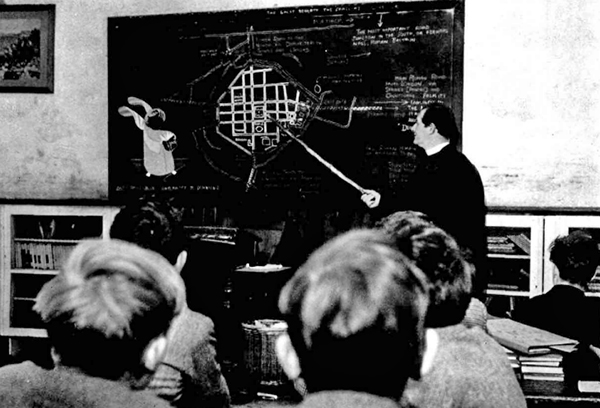
Dinnis was also responsible for giving all Wellingtonians weekly Divinity lessons, and memories of these are remarkably consistent:
‘His lessons were chiefly memorable for his fascinating and elaborate chalk drawings that took up most of the lesson.’ Peter Gardner (Hardinge 1946-51)
‘Dudley Dinnis, a delightful man who specialised in drawing heavenly angels in coloured chalk on his classroom blackboard.’
Anthony Collett (Combermere 1953-58)
‘Rev Dudley Dinnis, who never mentioned religion, allowed us to read our own books and produced very impressive pictures in chalk on the blackboard. I recall being very impressed (and am still) by the words, “One thing only I know and that is that I know nothing” [Socrates?] Had there been any discussion on such a topic, I think I would have been interested in joining in.’ Nick Harding (Combermere 1951-55)
‘RE lessons consisted of him spending most of the time carefully drawing the journeys of St Paul on the blackboard in coloured chalk. I think I obtained about 20% in my School Certificate. But one boy scored zero, and the school stopped taking it.’ Richard Harries (Hill 1949-54)
‘The Chaplain impressed us through the magnificent and ornate drawings he made in coloured chalks on the blackboard. I remember one entitled something like “Scene of animality and jungular activity.”’ Michael Llewellyn-Smith (Orange 1952-57)
‘Whenever one entered his classroom, he had almost invariably produced (in crayon on the blackboard) the most wonderfully colourful abstract work of art. He would ask for our opinion of his latest work; having passed judgement he would always make a point of telling us not to read any messages or symbolism into his design; it was more important that we just liked the look of it! A stricture I have carried me when looking at art ever since!’ Jeremy Watkins (Blucher 1951-55)
‘They were masterpieces; I can still see as clearly as if it were yesterday his drawing of an angel banking in space. The drawing combined a sense of movement with that of majesty, which was breathtaking.’ Richard Merritt (Picton 1954-59)
A couple of respondents remembered another detail:
‘DD just used to put a tick on termly reports, hoping that one had attended.’ Bobby Baddeley (Picton 1948-52)
‘His contribution to reports comprised just a tick… when we assembled for Divinity, nothing much was taught. Was there even lively debate? I cannot remember. Legend has it that one boy smoked a whole cigarette at the back of the class.’ Douglas Miller (Benson 1951-56)
Confirmation
As some OWs have mentioned, it was normal for most to be confirmed into the Church of England while at Wellington. Some have particular memories of this experience:
‘We were expected to be confirmed. Interviewed by my Tutor for this, he asked, “Have you looked into the other religions, Buddhism for example?” “Yes, sir,” I replied, though I had hardly heard the word Buddhism before. But duly confirmed I was, and took it seriously to the extent I knew something was expected of me. Once a week there was a voluntary communion service in the evening and I remember going once or twice. It provided a place of peace, a touch of what later I would think of as “the peace which passeth all understanding.”’ Richard Harries (Hill 1949-54)
‘I was prepared for Confirmation by W O Chadwick – we went to his rooms every week for bread and treacle, lots of chat about College affairs, and a short, but very significant, talk about Confirmation, his words I have never forgotten.’ John Hoblyn (Hardinge 1945-50)
‘I remember Chapel being important in my life, especially after Confirmation, and regularly went to communion. There, the elements were known as “Holy Swipes!”’ Vernon Phillips (Murray 1951-54)
‘I was confirmed by the Bishop of Oxford and I liked attending the quiet early morning Holy Communion services.” Christopher Stephenson (Hill 1949-54)
‘I was a “cradle” Anglican. Chapel was a life-saver. I learned the power and assurance of monastic offices – daily Chapel, matins, and evensong every Sunday. I was confirmed by the Bishop of Oxford, then asked by the Chaplain, “Dudley D” Dinnis, to be an 8am midweek Holy Communion server. This and much else from Chapel carried with me throughout life.’ Tim Reeder (Picton 1949-53)
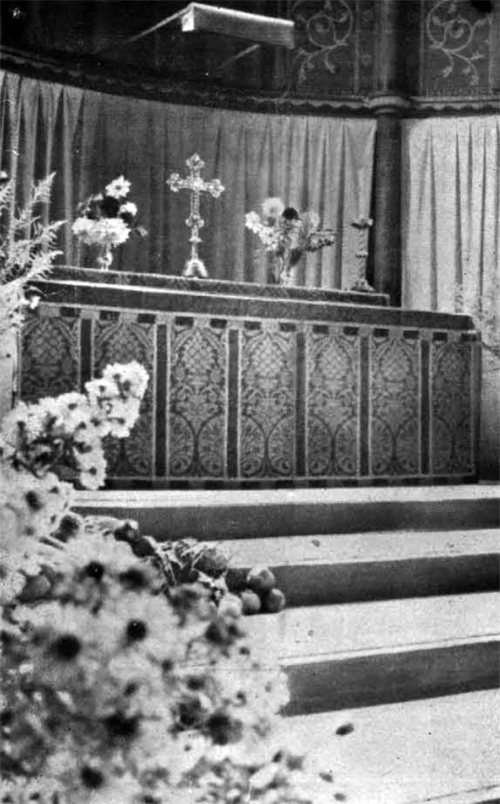
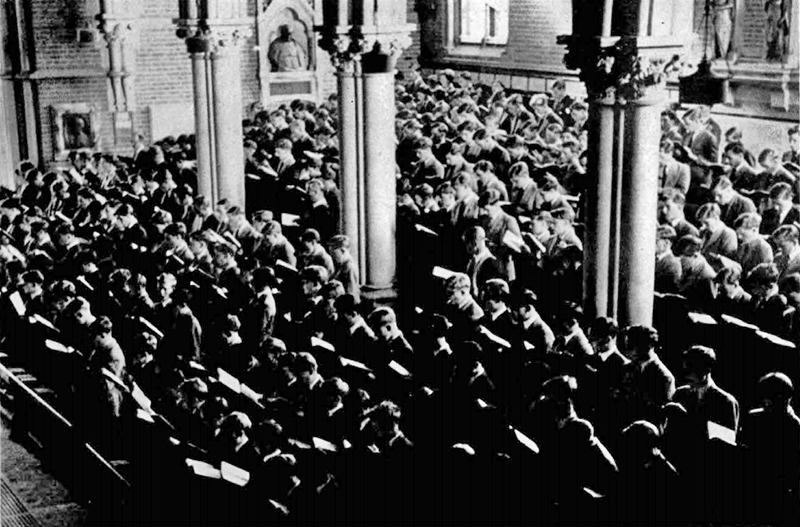
Sermons and preachers
The Sunday evening Chapel service included a sermon.
Charles Wade (Lynedoch 1947-50) recalls this was ‘normally given by a visiting preacher. They were often rather gloomy with a “Hell-fire” element.’ John Thorneycroft (Benson 1953-58) believes that the preacher was ‘often a nationally-known figure,’ while Richard Craven (Hill 1950-54) recalls ‘being happily distracted by a bat flying up and down the aisle during boring sermons and that sermons by the visiting Chaplain from Bradfield College were popular because they were always short.’
Other OWs had more positive memories:
‘In Lent, there were voluntary evening addresses to attend, given by visiting preachers, and I particularly remember one inspired series given by a Franciscan monk.’ Christopher Stephenson (Hill 1949-54)
‘The College was visited each term by two brown-habited Anglican Franciscan friars from Cerne Abbas in Dorset… The friars were tremendous people. Their “holiness,” energy, faith, humour, and powers of persuasion were obvious.’ Robert Waight (Orange 1942-46)
‘We were inspired by the monks who gave a series of Lenten addresses. These were always “down to earth,” with practical life advice, usually delivered with a certain level of humour. On one such occasion, recognising that Tinea Pedis was a fairly common affliction, one of our Franciscans reflected, “As you consider your pink-painted toes in the morning, also consider the lilies of the field,” etc.’ Peter Rickards (Murray 1947-52)
Leaving Chapel
Leaving Chapel after the morning service had its own traditions:
‘The Upper Ten step was occupied by eagle-eyed College Prefects as we streamed out. Did we have the requisite number of jacket buttons done up? Did we fail to “tick” an usher on the way out?’ Peter Rickards (Murray 1947-52)
‘On the way out of Chapel, one passed two College Prefects either side of the door who checked that shoes were clean, hair brushed, etc.’
Charles Ward (Hopetoun 1951-55)
‘Not being a College Prefect, I used to lead Picton out. We followed Benson, who were first, and I always left a dignified gap between us.’ Bertram Rope (Picton 1949-54)
‘How we got in and out of Chapel in fifteen minutes each day, I cannot imagine.’ Bobby Baddeley (Picton 1948-52)
Other memories
There are some memories of Chapel which cannot be easily categorised, such as the following selection:
‘The Chapel had a War Memorial tucked away in a corner, which was convenient for taking girls behind for a kiss and a cuddle when we had the once-a-year ball with the local all-girls schools.’ Ian Nason (Orange 1950-54)
‘My Jacobite proclivity led me to paste in my Wellington prayer book the name of King Rupert on a slip over that of King George in the prayer for the Royal Family, and follow the lessons in a Gaelic Bible.’ Nikolai Tolstoy-Miloslavsky (Stanley 1949-53)
‘We were always cynically amused by our weekly prayer for the soul of Edward White Benson, “Archbishop of Canterbury and one time Master of this College.” We thought that if his soul had not yet reached Heaven after six hundred boys had weekly prayed for this to happen, there must have been something seriously amiss. Living now in Cornwall and knowing much more of Benson, I am inclined to believe his soul needed all the prayers we could offer.’ Hugo White (Hardinge 1944-48)
‘Other memories remain. One is of two members of staff kneeling devoutly for a short period after the formal prayers in Chapel. They were very different: one at the centre of a coterie of bright historians, who later tried his hand at being a monk, the other a scientist hopeless at keeping discipline in class. Strange that I should remember this apparently insignificant detail. Was it the prayers of a few faithful souls that later bought forth fruit in some boys?’ Richard Harries (Hill 1949-54)
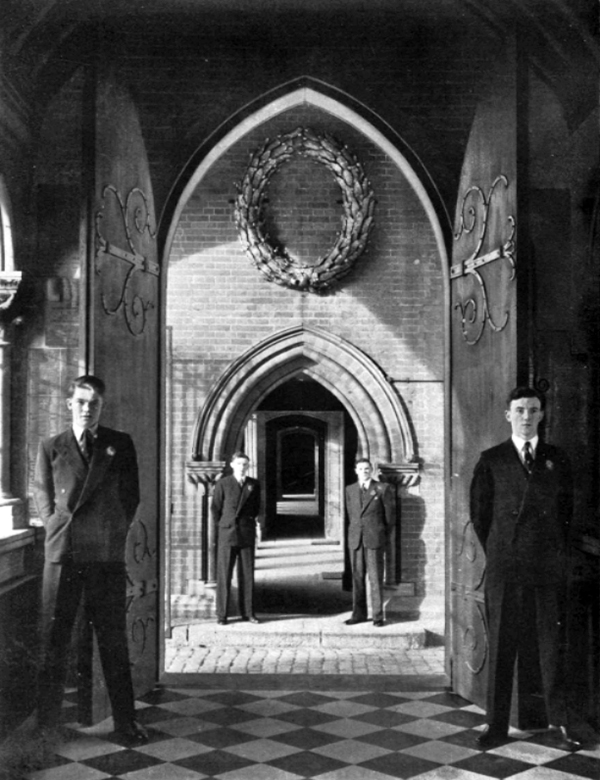
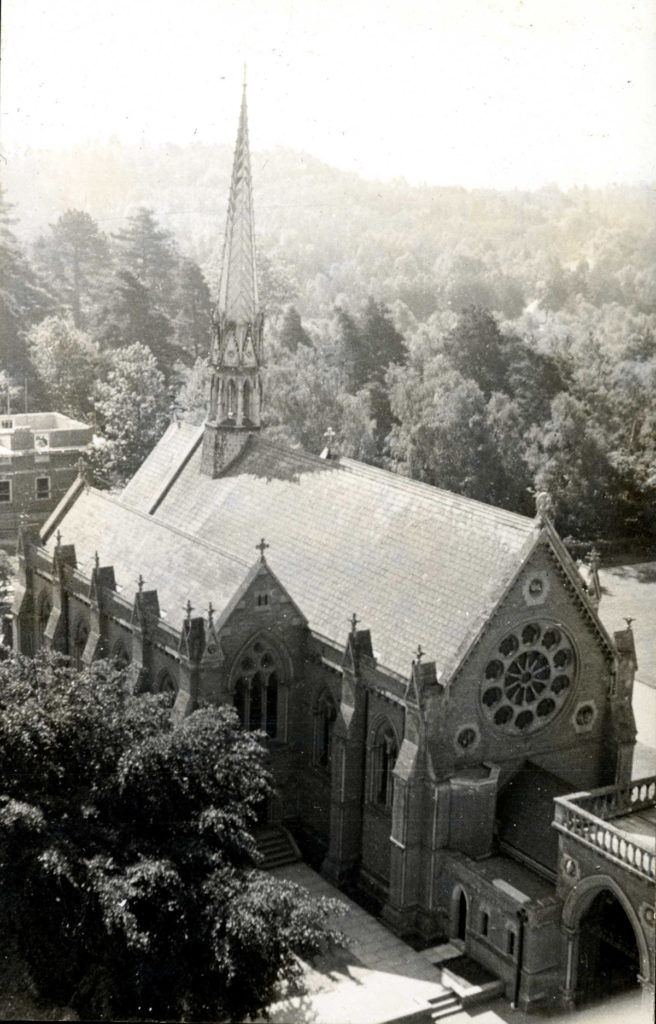
A place of solace
In summary, it seems that most OWs from the 1940s and ‘50s remember Chapel with some fondness, whether this was due to the music, the likeable Chaplain or a combination of other factors which some have eloquently put into words:
‘I suppose it was the most important place at College for giving one the feeling of being part of history and of following in a tradition. I have for many years been a Buddhist but never regret all I learned in Chapel.’ Martin Kinna (Murray 1953-58)
“I enjoyed being as one “family” in a communal gathering all with the same intention. I also remember getting comfort from going to voluntary chapel.’ Graham Stephenson (Combermere 1953-57)
‘I liked the sense of continuity one got – this was how our forebears, 400 years earlier, had worshipped the same God.’ Alastair Wilson (Talbot 1948-1950)
‘I found the voluntary evening services a means of escape and tranquility from the severity of College life.’ Nigel Hamley (Hill 1952-55)
‘What mattered was the feeling of peace and calm, a refuge from the rough and tumble of school life.’ Michael Llewellyn-Smith (Orange 1952-57):
‘A solace.’ John Flinn (Combermere 1944-49):
Perhaps the whole feeling is best summarised by these words from Colin Mattingley (Talbot 1952-56):
‘The service on Sunday evening was a really comforting gathering with the dusk gathering and the lights welcoming. It was a period of quiet reflection with an opportunity for renewal in preparation for the coming week. As darkness gathered outside, and the candles were lit, an atmosphere of contemplation permeated with the quiet sounds of the hymn, inevitably, “now the day is over, the night is drawing nigh, shadows of the evening creep across the sky.” You didn’t have to be particularly religious to feel the warmth of togetherness and mutual support set in place by the Chaplain’s reassuring words of renewal.’